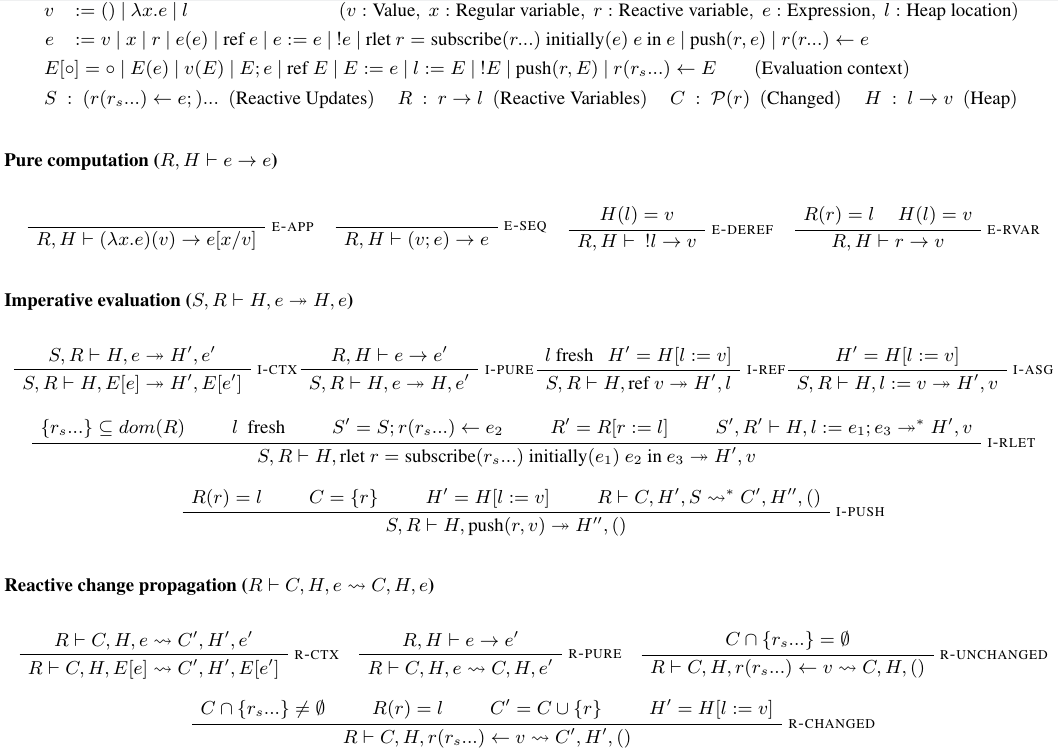Reactive Programming with Reactive Variables
Christopher Schuster, Cormac Flanagan
University of California, Santa Cruz
{cschuste, cormac}@ucsc.edu
Example Application: A Stopwatch
Graphical User Interface
Internal State
Time: 0
{
paused: false,
time: 0
}
Stopwatch: Imperative Implementation
var time = 0;
var paused = false;
setInterval(function() {
if (!paused) {
time++;
$("#time").text("Time: " + time);
}
}, 1000);
$("#button").click(function() {
paused = !paused;
$("#time").text(
paused ? "Paused" : "Time: " + count);
});
Stopwatch: Reactive Programming with RxJS
var pausedSig = Rx.Observable
.fromEvent($("#button"), "click")
.scan(function(paused) {return !paused;},false)
.startWith(false);
var timeSig = Rx.Observable.interval(1000)
.pausable(pausedSig)
.scan(function(c) { return c + 1; }, 0)
.startWith(0);
Rx.Observable.combineLatest(timeSig, pausedSig,
function(time, paused) {
return paused ? "Paused" : "Time: " + time;
})
.subscribe(function(s){$("#time").text(s);});Libraries for Reactive Programming
Advantages
- Provide data structures for creating and composing signals
- No language extension or custom runtime necessary
Disadvantages
- Programs consists of two kinds of values
- "Normal" values, e.g.
23,"foo",[1,2,3] - "Reactive" values (signals/behaviors), e.g. stream of mouse clicks
- "Normal" values, e.g.
- Primitive operations need to be lifted to reactive values
Goal: Reactive Programming without Signals
Reactive Variable Updates
let i = 0;
let j = i + 1;
i = 3;
j = i + 1;
console.log(j); // 14
rlet i = 0;
rlet j = i + 1;
i = 3;
console.log(j); // 4
Normal assignments do not update dependent variables
Assignment to reactive variable i also updates dependent variable j
Stopwatch: Reactive Variables
rlet paused = initially(false)
subscribe($("#button").click)
!paused;
rlet time = initially(0)
subscribe(interval(1000))
paused ? time : time + 1;
rlet txt = paused ? "Paused" : "Time: " + time;
subscribe(txt) { $("#time").text(txt); }Reactive Change Propagation:
1. Triggering a Reactive Update
Assigning new values with imperative push updates
rlet txt;
txt = "foo";
Alternatively: Using subscribe syntactic sugar to automatically trigger updates for JavaScript functions expecting a callback
rlet txt = subscribe(input.changed) input.text();
Reactive Change Propagation:
2. Propagating Changes to Dependent Variables
Reactive variable referenced by other reactive variables automatically set up a dependency
rlet len = txt.length;Alternatively, subscribe can be used to denote a dependency without using the value
rlet lastChanged = subscribe(txt) Date.now();A reactive variable reference in its own definition denotes the previous value to enable stateful computation
rlet numChanged = subscribe(txt)
initially(0) numChanged + 1;Reactive Change Propagation:
3. Reacting to Updated Variables
Assignments might update dependent reactive variables which can be accessed like normal variables
console.log(numChanged); // "23"
txt = "bar";
console.log(numChanged); // "24"Alternatively, a special subscribe syntax can be used to invoke imperative code at each change
subscribe(numChanged) { console.log("goo"); }
txt = "bar"; // "goo"Demo (https://levjj.github.io/rlet)
Implementation (1/2)
rlet is a macro-generating macro (using the sweet.js macro system)
- each reactive variable defines a scoped macro
- assignments to the reactive variable trigger push updates on the underlying signal
- normal references simply return the last/current value
- implicit subscriptions due to reactive variable references require local expand, parse and scope analysis during macro expansion
Github Repository: https://github.com/levjj/rde/
Online Live Demo: https://levjj.github.io/rde/
Implementation (2/2)
rlet i = 0;
rlet j = i + 1;
i = 3;
console.log(j);
var S_i = new Sig(function(){
return 0;
}, null);
var S_j = new Sig(function(){
return IMM(S_i).read() + 1;
}, null);
S_i.onUpdate(S_j);
S_i.push(3);
console.log(S_j.read());Side effects during reactive change propagation
Manipulating global state during change propagation results in additional, non-reactive data dependencies
var x = 1;
Rx.Observable.interval(100)
.map(function() { return x * x; }) // x2 ≈ x*x
.map(function(x2) { x++; return x2; });
.subscribe(function(x2) { alert([x, x2]); });
// ≈ alert([x, x*x]); [1,1], [2,4], [3,9], [4,16] ...[2,1], [3,4], [4,9], [5,16] ...Prevent global state mutation
All references to surrounding variables in update expression of rlet are wrapped in IMM()
function IMM(x) {
return new Proxy(x, {
get: function(target, key) {
return IMM(target[key]); },
set: function() {
throw new TypeError('immutable!'); }
});
};Formal Semantics

Discussion
Advantages
- No reactive values, so no lifting required
- Dependencies determined by lexical scope
- Easy to reason about
- Acyclic dependency graph
- Can be re-evaluated without glitches
Disadvantages
- Reactive variables cannot be reified and passed around as values
- No higher-order reactive programming
- Generic operations like filter cannot be implemented just in terms of reactive variables
Future Work
Static mapping of reactive dependencies to lexical scopes as basis for debugging and visualizations for reactive programming
Asynchronous updates of reactive variables
Continuous reactive variables that do not propagate updates with unchanged values